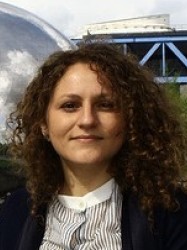Research overview
My research focusses on the development of mathematical models and statistical learning methods for applications in biomedicine and bioinformatics. It can be divided into two main themes:
- Dynamical modelling and inference in complex networks, such as protein reaction networks, in particular to tackle the problem of network reconstruction for intracellular signalling and regulation;
- Statistical inference approaches to the characterization of protein-protein binding mechanisms underlying protein allostery and the specificity of immune responses.
Complex biochemical networks

Many biological systems involve the interaction of numerous components and exhibit complex behaviours: a remarkable example are the biochemical reaction networks building up signalling pathways. Understanding functional dependencies in these networks, and ultimately how signalling maps onto responses, is crucial to design therapeutics that can target signalling dysregulation.
Both fundamental and practical limitations have emerged in quantitative approaches to studying these systems, because of the extremely large number of reacting species, nonlinearities in the dynamics and their non-trivial interplay with stochasticity. The comparison itself with experimental results can be subject to an overall uncertainty due to missing variables and low-resolution measurements. To deal with these scenarios, in my PhD I developed statistical physics frameworks of approximate description and inference, the aim being to simplify the overall analysis and to facilitate the interpretation of experimental data. My PhD work relied on a path integral formulation of reaction-diffusion processes , such as the ones describing dynamics in protein-protein interaction networks. In such networks, one can imagine selecting a 'subnetwork', i.e. , a subset of nodes of interest, either because they are better characterized from the theoretical point of view or because they are the only ones to be observed experimentally. The subnetwork is embedded in a larger network (the 'environment'), which is unobserved. In this setting, I used the path integral formulation of the dynamics to tackle two complementary questions: (i) what can we infer about the state of the nodes in the environment, assuming that we know the structure of the network; (ii) how can we coarse-grain the description over the environment to obtain a model reduced to the subnetwork that still is able to account for the effect of the embedding environment.
Currently, I build on this expertise to develop methods of network reconstruction in the framework of stochastic mechanistic models of biochemical regulation and signalling pathways.
Immune recognition

Broadly speaking, the immune response is based on recognition of amino acid patterns of proteins, and only proteins that have patterns detected as `foreign' to the organism are targeted by an immune response. Working directly with sequencing datasets that realize a sampling of the processes involved in immune responses, I have designed, through statistical inference approaches, data-driven, physics-inspired models that accurately describe patterns at the amino acid level able to inform us about the molecular mechanisms of immune recognition of infected and malignant cells.
Specifically, I focus on T cells cells of the adaptive immune system that recognize and kill malignant or infected cells. Recognition by a T cell occurs via a specific binding of its receptor to antigens, short protein fragments that are presented on the cell surface by specialized complexes, the Human Leukocyte Antigen (HLA) protein complexes. The quantitative characterization of the molecular determinants of T-cell recognition is far from complete. With the advent of high-throughput sequencing technologies, one can map in substantial de-tail repertoires of presented antigens and T-cell receptors in terms of sequence. An outstanding problem is thus how to turn statistical patterns at the sequence level into predictive models of T-cell response.
In my work so far, I have built, through a machine learning scheme known a Restricted Boltzmann Machine, sequence-space probabilistic models that are able to predict antigen presentation on specific HLA proteins and T-cell response upon antigen stimulation in samples from cancer patients. Currently, my interest is in data-driven dynamical models of the response by T cells to presented antigens based on the statistical characterization of antigen-receptor interactions.

